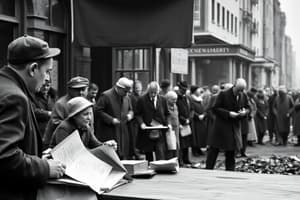Podcast
Questions and Answers
Which of the following best describes a primary criticism of the unemployment relief camps during the Great Depression?
Which of the following best describes a primary criticism of the unemployment relief camps during the Great Depression?
- They were operated by foreign entities and did not benefit the Canadian economy.
- They failed to offer any form of compensation, leaving workers in a state of complete destitution.
- They exploited laborers by offering minimal pay and denying them basic rights, such as the ability to strike. (correct)
- They provided luxurious accommodations and attracted individuals who were not truly in need.
What was a significant risk associated with 'riding the rails' during the Great Depression?
What was a significant risk associated with 'riding the rails' during the Great Depression?
- The constant availability of food and shelter on board led to widespread illness.
- The risk of severe injury or death from falling under moving trains or confrontations with railroad police. (correct)
- Government subsidies made rail travel expensive and unaffordable.
- The trains only traveled to areas with no available work.
How did the 'pogey' system impact the nutritional status of those relying on it during the Great Depression?
How did the 'pogey' system impact the nutritional status of those relying on it during the Great Depression?
- It improved access to a variety of food, ensuring sufficient nutrition for everyone.
- It provided a balanced diet of fresh produce and essential nutrients to combat malnutrition.
- It allowed recipients the freedom to purchase goods from any store, promoting healthy eating habits.
- It restricted access to fresh and nutritious food, worsening malnutrition among recipients. (correct)
What was a consequence of the extreme drought in Canada’s Palliser Triangle during the Dirty Thirties?
What was a consequence of the extreme drought in Canada’s Palliser Triangle during the Dirty Thirties?
Beyond the agricultural sector, what was a common experience for many urban dwellers during the Great Depression?
Beyond the agricultural sector, what was a common experience for many urban dwellers during the Great Depression?
What challenges did soldiers face when discharged from military training camps during winter in the late 1930s?
What challenges did soldiers face when discharged from military training camps during winter in the late 1930s?
How did the government's response to unemployed individuals during the Great Depression reflect a balance between assistance and control?
How did the government's response to unemployed individuals during the Great Depression reflect a balance between assistance and control?
During the Great Depression, what were the long-term effects of the drought in the Palliser Triangle and the subsequent migration of farmers?
During the Great Depression, what were the long-term effects of the drought in the Palliser Triangle and the subsequent migration of farmers?
Flashcards
Unemployment Relief Camps
Unemployment Relief Camps
Controversial camps during the Great Depression that paid unemployed men very little for hard labor.
Riding the Rails
Riding the Rails
Traveling on freight trains illegally in search of work or just to move from place to place during the Great Depression.
"Pogey" or "The Dole"
"Pogey" or "The Dole"
Government unemployment relief given in the form of vouchers exchangeable for goods.
Palliser Triangle
Palliser Triangle
Signup and view all the flashcards
Survival Strategies
Survival Strategies
Signup and view all the flashcards
Role of Charities
Role of Charities
Signup and view all the flashcards
Military Training Camps Conversion
Military Training Camps Conversion
Signup and view all the flashcards
Influenza Outbreaks
Influenza Outbreaks
Signup and view all the flashcards
Study Notes
- The Great Depression caused widespread unemployment, leading many men to seek work elsewhere.
Unemployment Relief Camps
- Established to provide work during the Depression, the camps paid workers $0.20 per day for hard labor such as road construction.
- Living conditions were poor, and they were viewed as exploitative due to the lack of worker rights and the inability to strike.
Riding the Rails
- Many men and teenagers without money hopped on freight trains in search of work.
- Over time, it became a way for the homeless and jobless to move without a destination
- Authorities only half-heartedly tried to stop riders.
- The practice was dangerous, leading to injuries, death, and violence from railroad police, or "bulls."
- Riders commonly faced harsh weather, hunger, and illness.
The "Pogey" Struggle
- "Pogey" (unemployment relief) was the last resort for those with no other options.
- The government provided vouchers instead of money, limiting purchases to cheap, low-nutrition food and worsening malnutrition.
- Relief was limited with strict requirements.
The Dirty Thirties
- Farmers in Canada’s Palliser Triangle experienced severe drought and relentless winds, causing farms to turn to dust that blew away.
- Many families abandoned their farms.
Impact on Everyday Life
- Factories shut down and cities saw mass unemployment.
- People sold items door-to-door, begged, relied on charities, and drifted from town to town.
Military Training Camps and Disease
- Some relief camps were converted to military training camps in the late 1930s.
- Poor conditions led to influenza outbreaks.
- Discharged soldiers often lacked proper clothing for winter conditions.
Studying That Suits You
Use AI to generate personalized quizzes and flashcards to suit your learning preferences.
Description
During the Great Depression, unemployment led to desperate measures. Relief camps offered meager wages for hard labor under harsh conditions. Many men also rode freight trains seeking work, facing danger and hardship in their search for employment.




